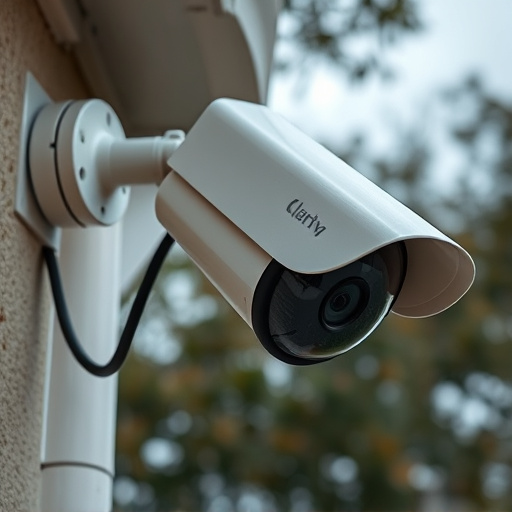Understanding the psychology behind fake security camera placement is crucial for effective crime prevention. By strategically positioning decoy cameras in high-risk areas like entrances, exits, and vulnerable points at eye level or slightly elevated with clear lines of sight, potential criminals are deterred, leading to lower crime rates. The best placement leverages environmental factors such as natural light, terrain elevation, and obstructions for maximum effectiveness, focusing on high-visibility areas with comprehensive coverage. Targeting high-risk zones like entrances, exits, loading docks, and back alleys sends a powerful surveillance message, while angling cameras addresses blind spots around physical barriers. The optimal setup captures both close-up and wide-angle views, creating a convincing network of cameras in high-traffic areas with visible landmarks to deter potential criminals.
“Enhance your home or business security—literally—with a strategic fake security camera placement strategy. This comprehensive guide explores the psychology behind manipulating would-be intruders, considering environmental factors for optimal deception. Learn about key areas to target and advanced techniques to maximize the illusion of security. Discover the best placement for fake security cameras to deter crime effectively while saving on real surveillance costs.”
- Understanding the Psychology Behind Fake Security Camera Placement
- Environmental Factors to Consider for Effective Deception
- Key Areas to Target with Strategic Camera Positioning
- Advanced Techniques for Maximizing the Illusion of Security
Understanding the Psychology Behind Fake Security Camera Placement
Understanding the psychology behind fake security camera placement is key to an effective strategy. Criminals often look for areas with minimal surveillance, making it crucial to place fake cameras in visible locations that deter potential criminals. The mere presence of these decoys can significantly reduce actual crime rates, as offenders are less likely to target high-risk zones.
The best placement for fake security cameras involves a mix of strategic positioning and realistic appearance. They should be mounted at eye level or slightly elevated, mimicking the angles used by real surveillance equipment. Placement near entrances, exits, and vulnerable areas like ATMs or cash registers is ideal. Additionally, ensuring the cameras have clear lines of sight and are not obstructed by vegetation or other objects enhances their deterrent effect.
Environmental Factors to Consider for Effective Deception
When considering the best placement for fake security cameras as a deception strategy, environmental factors play a crucial role in their effectiveness. The natural surroundings and existing infrastructure can either enhance or limit the impact of these decoys. For instance, high-visibility areas with ample natural light during the day and well-lit streets at night are ideal locations. Fake cameras placed strategically under trees or on buildings can blend into the environment, making them hard to distinguish from genuine surveillance equipment.
Additionally, factors like terrain elevation and obstructions can influence camera placement. Mounting fake cameras on elevated surfaces or behind structures creates a sense of depth and realism. Overlooking open spaces or intersections allows for comprehensive coverage while remaining relatively hidden. Understanding these environmental elements helps in creating an immersive deception network, deterring potential intruders, and providing a false sense of security.
Key Areas to Target with Strategic Camera Positioning
When strategizing fake security camera placement, identifying key areas is crucial for maximizing their deterrent effect. High-risk zones such as entrances and exits, loading docks, and back alleys should be top priorities. Positioning cameras in these areas sends a clear message to potential intruders that they are under constant surveillance.
The best placement for fake security cameras also considers the blind spots around physical barriers like fences or walls. Strategically placing them at angles that cover these hidden areas ensures comprehensive monitoring of the property. Additionally, cameras should be positioned to capture both close-up and wide-angle views, providing detailed evidence in case of any incidents.
Advanced Techniques for Maximizing the Illusion of Security
To maximize the illusion of security, strategically placing fake security cameras is key. Position them in areas that offer clear views but are also relatively hidden, mimicking the placement of real surveillance equipment. Overlapping or multiple camera angles can create a more convincing network, giving the appearance of constant monitoring.
Consider environments with high foot traffic and visible landmarks as ideal best placement for fake security cameras. Retail stores, banks, or public spaces benefit from this tactic by deterring potential criminals due to the perceived increased risk of being watched. Combining this with realistic camera appearances and irregular positioning can further enhance the overall effect, serving as a powerful visual deterrent.
When employing fake security camera placement strategies, understanding human psychology and environmental considerations is key to creating an effective deception. By targeting specific areas and utilizing advanced techniques, you can maximize the illusion of security. Remember, the best placement for fake security cameras should blend seamlessly with genuine ones, providing a false sense of safety that deters potential threats.
